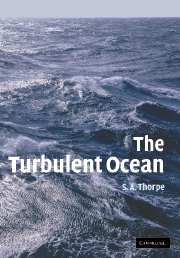Book contents
- Frontmatter
- Contents
- Preface
- Structure and résumé
- Acknowledgements
- 1 Heat, buoyancy, instability and turbulence
- 2 Neutral stability: internal waves
- 3 Instability and transition to turbulence in stratified shear flows
- 4 Convective instabilities
- 5 Instability and breaking of internal waves in mid-water
- 6 The measurement of turbulence and mixing
- 7 Fine-structure, transient-structures, and turbulence in the pycnocline
- 8 The benthic boundary layer
- 9 The upper ocean boundary layer
- 10 Shallow seas
- 11 Boundary layers on beaches and submarine slopes
- 12 Topographically related turbulence
- 13 Large-scale waves, eddies and dispersion
- 14 Epilogue
- Appendices
- References
- Index of laboratory experiments
- Subject index
- Plate section
2 - Neutral stability: internal waves
Published online by Cambridge University Press: 05 June 2012
- Frontmatter
- Contents
- Preface
- Structure and résumé
- Acknowledgements
- 1 Heat, buoyancy, instability and turbulence
- 2 Neutral stability: internal waves
- 3 Instability and transition to turbulence in stratified shear flows
- 4 Convective instabilities
- 5 Instability and breaking of internal waves in mid-water
- 6 The measurement of turbulence and mixing
- 7 Fine-structure, transient-structures, and turbulence in the pycnocline
- 8 The benthic boundary layer
- 9 The upper ocean boundary layer
- 10 Shallow seas
- 11 Boundary layers on beaches and submarine slopes
- 12 Topographically related turbulence
- 13 Large-scale waves, eddies and dispersion
- 14 Epilogue
- Appendices
- References
- Index of laboratory experiments
- Subject index
- Plate section
Summary
Introduction
The mean ocean stratification
The ocean is ‘stratified’, the mean density increasing with depth. The region immediately below the sea surface is, however, often of almost uniform density to a depth of typically 50 m, but with diurnal, seasonal and latitudinal variations in both density and depth. In regions of large water depth, this ‘mixed layer’ is stirred and sustained mainly by the turbulent processes arising from air–sea interaction described in Chapter 9. In parts of the shallow shelf seas, the turbulence caused by the tidal flow over the seabed may dominate, mixing the entire water column, including that near the surface, to a nearly uniform density.
Below the surface mixed layer, the density increases with depth in a layer known as the ‘pycnocline’. The density increase is most commonly related to a decrease in temperature and, varying seasonally, the pycnocline is then usually called the seasonal ‘thermocline’. Its mean buoyancy frequency, N, is typically about 10−2 s−1. In some regions, however, particularly near a source of freshwater, as in a river estuary, fjord or near melting ice, the density increase may be mainly a consequence of increased salinity (a ‘halocline’). At all depths, the density generally increases monotonically with depth, but irregularly, exhibiting variable gradients or density ‘fine-structure’, the causes of which are discussed in Section 7.2.
Deeper in the pycnocline, the mean temperature decreases further with depth through a ‘main thermocline’ at 500–1000 m depth.
- Type
- Chapter
- Information
- The Turbulent Ocean , pp. 44 - 79Publisher: Cambridge University PressPrint publication year: 2005



